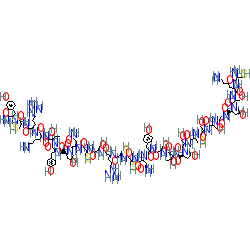|
Compound class:
Peptide or derivative
Comment: From Conus geographus (Geography cone). Cleaved into ω-conotoxins GVIB and GVIC.
Ligand Activity Visualisation ChartsThese are box plot that provide a unique visualisation, summarising all the activity data for a ligand taken from ChEMBL and GtoPdb across multiple targets and species. Click on a plot to see the median, interquartile range, low and high data points. A value of zero indicates that no data are available. A separate chart is created for each target, and where possible the algorithm tries to merge ChEMBL and GtoPdb targets by matching them on name and UniProt accession, for each available species. However, please note that inconsistency in naming of targets may lead to data for the same target being reported across multiple charts. ✖ |
Peptide Sequence  |
|
| CKSPGSSCSPTSYNCCRSCNPYTKRCY | |
| Cys-Lys-Ser-Pro-Gly-Ser-Ser-Cys-Ser-Pro-Thr-Ser-Tyr-Asn-Cys-Cys-Arg-Ser-Cys-Asn-Pro-Tyr-Thr-Lys-Arg-Cys-Tyr | |
| Post-translational Modification | |
| C-terminal tyrosine residue undergoes amidation; proline residues at positions 4, 10 and 21 are 4-hydroxyproline; disulphide bond formation between cysteine residues at positions 1 and 16, 8 and 19, and 15 and 26. | |
Download 2D Structure  |
|
| Canonical SMILES | Download |
| Isomeric SMILES | Download |
| InChI standard identifier | Download |
| InChI standard key | Download |
Molecular structure representations generated using Open Babel







